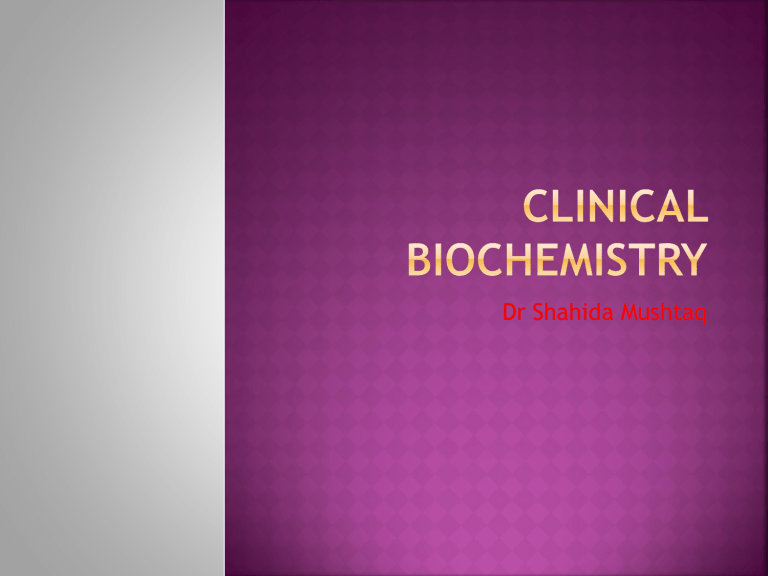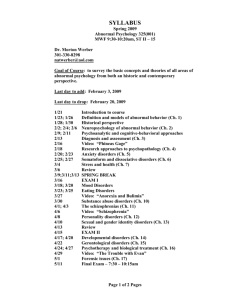Clinical biochemistry

Dr Shahida Mushtaq
provides advanced understanding and applied knowledge in the theory and practice of
Clinical Biochemistry
a critical understanding of how biochemical investigations are employed to develop a clinical diagnosis
Help you in developing necessary professional and research skills to promote lifelong learning and career development
Disorders of Protein Metabolism:
Non-protein nitrogenous compounds (Urea, uric acid
& amino acids):
Their normal plasma levels
Disease states associated with their increased and decreased levels in the plasma.
Plasma Proteins:
Normal and abnormal levels of plasma proteins and diseases associated with increased and decreased levels.
Immunochemistry
Components of the immune system.
Diseases associated with disorders in the immune system, multiple myeloma, systemic lupus erythromatosis, heavy-chain diseases, macroglobulinemia etc.
Clinical Enzymology
Changes in enzymatic activity in disease states
Hemoglobin
Normal and types of abnormal hemoglobins.
Pathological cases associated with abnormal hemoglobin, e.g., thalassemia, sickle cell anemia etc.
Disorders of Lipid Metabolism
Hyper and hypolipoproteinemia.
Atherosclerosis & lipidoses.
Fatty liver.
Disorders of Electrolytes, Blood Gases &Acidbase Balance
Sodium, potassium, chloride & their diagnostic value.
Gas transport in the blood (Oxygen & CO2).
Blood pH and its regulation.
Acidosis and alkalosis (Metabolic and respiratory)
& Pathological conditions associated with each condition.
Estimation of serum enzymes:
LDH and its isoenzymes.
CPK and its isoenzymes.
Aldolase
Leucine aminopeptidase.
Aspartate and Alanine Aminotransferases AST and
ALT.
Serum glucose
Lipid profile
Clinical Biochemistry, 2 nd Edition, 2008, R.
Luxton.
They arise from damaged gene leading to an abnormal enzyme.
They can affect many different biochemical pathways.
May be autosomal or sex linked.
Mutation in gametes and normal cells.
They involve inheritance of abnormal gene from one or both parents and are linked with abnormal enzyme leading to defect in metabolic pathway.
There may be defects in other types of proteins for example cystic fibrosis.
About 1300 diseases known so far.
About 100 start in the neonatal period
About 20 are amenable to treatment
Incidence:
rare
Suspect IEM in parallel to other common conditions e.g. Sepsis.
Non-specific signs and symptoms e.g. poor feeding, lethargy, failure to thrive.
Majority of cases may be sporadic.
Inborn errors of intoxication are usually amenable to treatment.
Group 1: Disorders that give rise to
Intoxication
Group 2: Disorders involving energy metabolism.
Group 3: Disorders involving complex molecules.
(Proposed by JM Saudubray-2002)
This group includes IEM that lead to acute or progressive intoxication from accumulation of toxic compounds proximal to metabolic block.
Includes:
Aminoacidopathies e.g:
Phenylketoneuria (PKU)
Maple Syrup Urine Disease (MSUD)
Tyrosinaemia type I
Organic acidaemias e.g.
Methylmalonic acidaemia (MMA)
Propionic Acidaemia
Isovaleric Acidaemia
Includes (Cont):
Congenital Urea Cycle Defects
Arginosuccinate Lyase Def
Ornithine Carbamyl Transferase Def
Sugar Intolerance
Galactosaemia
Hereditary Fructose Intolerance
This group consists of IEM with symptoms due at least partly to a deficiency of energy production or utilization. They result from a defect in the:
Liver
Myocardium
Brain
Muscle
Includes:
Hypoglycaemic disorders
Gluconeogenesis defects
Glycogenosis defects
Hyperinsulinism
Fatty Acid Oxidation Disorders
Includes (Cont)
Congenital Lactic Acidaemias
Pyruvate carboxylase deficiency
Krebs Citric Cycle defects
Mitochondrial Respiratory Chain defects
This group includes diseases that involve defects in the synthesis or the catabolism of complex molecules.
These diseases are:
Progressive
Permanent
Independent of intercurrent events
Not amenable to treatment.
Includes:
Lysosomal Disorders
Peroxisomal Disorders
Golgi Apparatus Disorders
Inborn Errors of Cholesterol Synthesis
23 pairs of chromosomes
Autosomal or sex linked
Homozygous or heterozygous
inheritance pattern is different for both autosomal or sex linked genes.
Expression of gene depends on dominence of genes.
An accumulation of the sustrate before enzyme defect.
Decrease in amount of product of enzyme.
An increased concentration of alternate metabolism
A decrease or absence of enzyme activity
Screening for the IBEM in individuals who do not have symptoms.
Investigations of the patients with symptoms of the IBEM.
Detecting a patient with an IBEM even before he shows overt symptoms of the disease
Screening should be done for high risk group
All newborn infants
Family of affected children
Expectant mothers who have previously had affected children (pre natal diagnosis)
There is suitable treatment available for the disease
The disease is life threatening or seriously debelitating
The disease has relatively high incidence
A suitable test is available
The cost is acceptable.
PHENYLKETONURIA AND CONGENITAL
HYPOTHYROIDISM
Infant may present with symptoms within few days after birth or within few weeks of life.
Failure to thrive
Poor feeding
Persistent vomiting
Unexplained jaundice
Unexplained hypoglycemia
Ketosis
Lactic acidosis
Convulsions and coma
Lethargy
Hypotonia hyperventilation
Plasma
Electrolytes
Acid base balance
Blood gases
Glucose
LFT
Calcium
Plasma
Insulin lactic acid
Ammonia ketones
Urine
Amino acid
Sugar
Organic acids
Parents of the affected children
Amniocentesis
Fibroblasts recovered from amniotic fluid
Cultured and specific enzyme studies are performed
15 th week should be completed by 20 th week
CVS
9 th week complete within 10 days
DNA analysis
Cystic fibrosis






